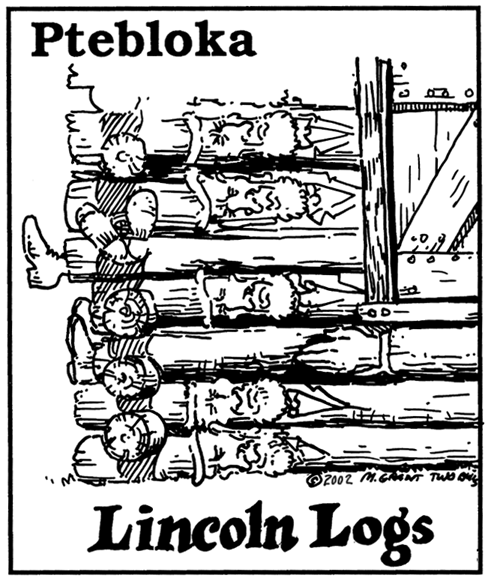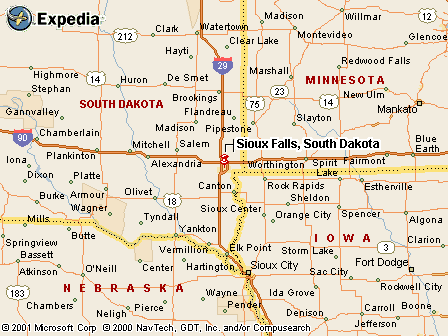|
|
Canku Ota |
|
|
(Many Paths) |
||
|
An Online Newsletter Celebrating Native America |
||
|
October 18, 2003 - Issue 98 |
||
|
|
||
|
Marty Two Bulls |
||
|
by Eulala
|
||
|
credits: graphics
copyright Marty Two Bulls
|
|
Marty Two Bulls is a very well spoken Lakota man who is becoming well known and very respected for expressing himself, not with his words, but with his hands. He is the cartoonist who creates the popular weekly editorial cartoons in the Indian Country Today newspaper. He lives in Sioux Falls, South Dakota, where he earns his living as Graphics Editor for the Argus Leader newspaper, but he has been drawing the one panel political cartoon in Indian Contry for the past two years. In those years as a cartoonist, he has covered most of the happenings in Indian country from a Native American perspective and gained a large following of fans, especially among Native Americans. Two Bulls says he has been drawing all of his life. As he was growing up he had two uncles who were professional artists. One worked in the fine arts field and the other one was a commercial artist. The commercial artist made a good dependable living and that influenced Marty to select that direction for his art. He attended Colorado Institute of Art in Denver, Colorado, and then began working at Duhamel Broadcasting Corporation as assistant to the art director. At that time he learned to shoot commercials for television and produced all their print advertisement. A year later he took a job as a graphic designer with Timberline Corporation doing illustrations and pre-press work. In 1989, he moved into the newspaper area in a job with Lakota Times, a weekly Native American news publication that eventually evolved into the popular Indian Country Today newspaper. From there, he worked for the State of South Dakota as a graphic designer before becoming the graphics editor for the Rapid City Journal in 1993. He was there for seven years.
To create the weekly editorial cartoons in Indian Country Today, he says the editor tells him what he will be writing about and Marty either comes up with a cartoon that goes with that subject or sometimes they collaborate on an idea for a graphic and a caption for it. But most of the time Marty has full choice of the cartoon’s content. Indian people who follow the ICT newspaper are very conscience that Marty knows Indians well and that is what keeps his material fresh and current. Marty says he reads a lot of newspapers, magazines and Indian periodicals in order to research topics and subjects for his cartoons and graphics art work. He is surprised how much he uses geometry in his line of work. Although the final product of the cartoon is graphic, he finds to be a cartoonist and graphic artist he must use a lot of the tools he learned in school. Tools like reading for research and keeping current on what is happening in the news; math for creating graphs, spread sheets and translating complicated information into an easy to understand visual form; and history and geography are important in putting information into context of the past, present, and future. In speaking about what it takes to be a good cartoonist, Marty says one must practice drawing all the time. He advises to watch others and be able to draw many kinds of faces, all kinds of bodies and many kinds of body languages. He says the best part of drawing cartoons is being around people, watching and interacting, and being able to see the funny side of almost everything. For him, the down side would be the constant deadlines, whether daily or weekly. He also says that cartooning is a small business and you have to always be aware of the profit and loss aspect of that business in order to be successful. When asked the names of cartoonists who influenced his work, Marty gives the names of John Severin and Wallace Wood, who both worked in comic books early on. As to other Natives active in cartooning, Two Bull mentioned Native cartoonist Jon Proudstar who is currently drawing and writing on his own comic book called "Tribal Force," a second edition about Native American superheros. Another is "Koda the Warrior" produced by Mark Mindt, a Spirit Lake Sioux tribal member. Marty has been married 20 years and has three children, ages 15, 17, and 19. He and his family participate in many traditional Lakota ceremonies and activities. Although he has limited time for art other than cartooning right now, he does produce a few pieces, as time allows, including sculptures and some paintings in both acrylic and watercolor. One piece of exciting news from Marty is the web site he has been creating and plans to post on the internet in the near future. He is now waiting to obtain a domain name before he launches the site. Interested fans can search the web occasionally under "Marty Two Bulls" to find the site as soon as it is initiated. Also in the future, Marty would like to pursue collecting some of the Lakota stories from tribal elders to be passed on to Indian children of the future. In the meantime, we hope he will continue using his hands to help us look at Indian country life with insightful humor. And, when the time comes, we hope he will be prepared to add his articulate voice to help raise up warriors for Native preservation, Native publications, and Native pride.
|
|
|
www.expedia.com |
|
|
||
|
|
||
| Canku Ota is a free Newsletter celebrating Native America, its traditions and accomplishments . We do not provide subscriber or visitor names to anyone. Some articles presented in Canku Ota may contain copyright material. We have received appropriate permissions for republishing any articles. Material appearing here is distributed without profit or monetary gain to those who have expressed an interest. This is in accordance with Title 17 U.S.C. Section 107. | ||
|
Canku Ota is a copyright © 2000, 2001, 2002, 2003 of Vicki Lockard and Paul Barry. |
||
 |
 |
|
|
The "Canku Ota - A Newsletter Celebrating Native America" web site and its design is the |
||
|
Copyright © 1999, 2000, 2001, 2002, 2003 of Paul C. Barry. |
||
|
All Rights Reserved. |
||
 Two
Bulls began cartooning professionally in 1989 when he created a
strip about his daughter. The strip was called "Deez,"
and the rest is history. About the same time, he also created the
one panel cartoon he called "Ptebloka," which means "bull"
in Lakota. He moved from there to producing professional editorial
cartoons. He says he likes cartooning because he enjoys drawing
them and making people laugh.
Two
Bulls began cartooning professionally in 1989 when he created a
strip about his daughter. The strip was called "Deez,"
and the rest is history. About the same time, he also created the
one panel cartoon he called "Ptebloka," which means "bull"
in Lakota. He moved from there to producing professional editorial
cartoons. He says he likes cartooning because he enjoys drawing
them and making people laugh. 
